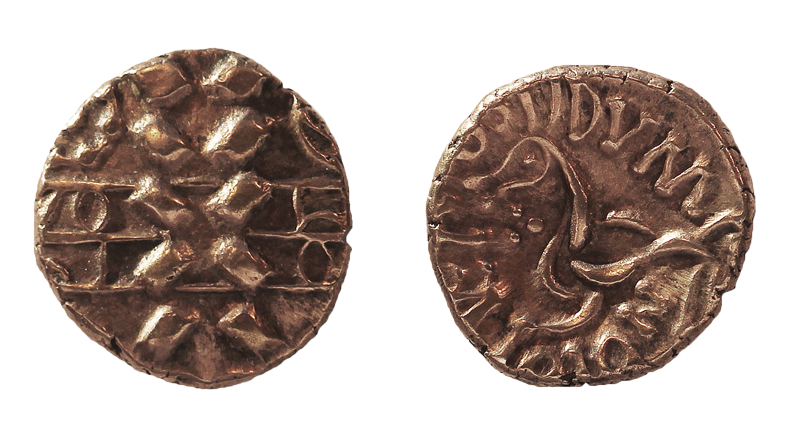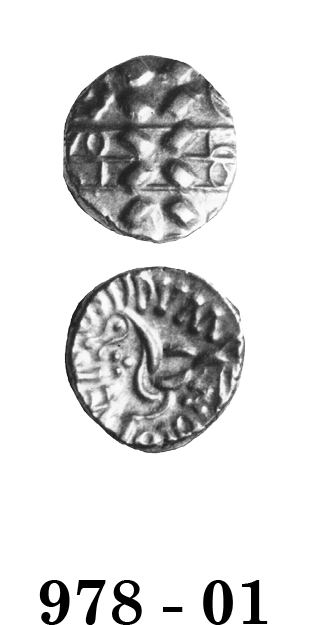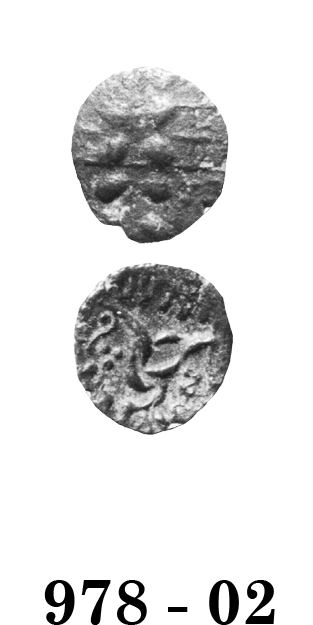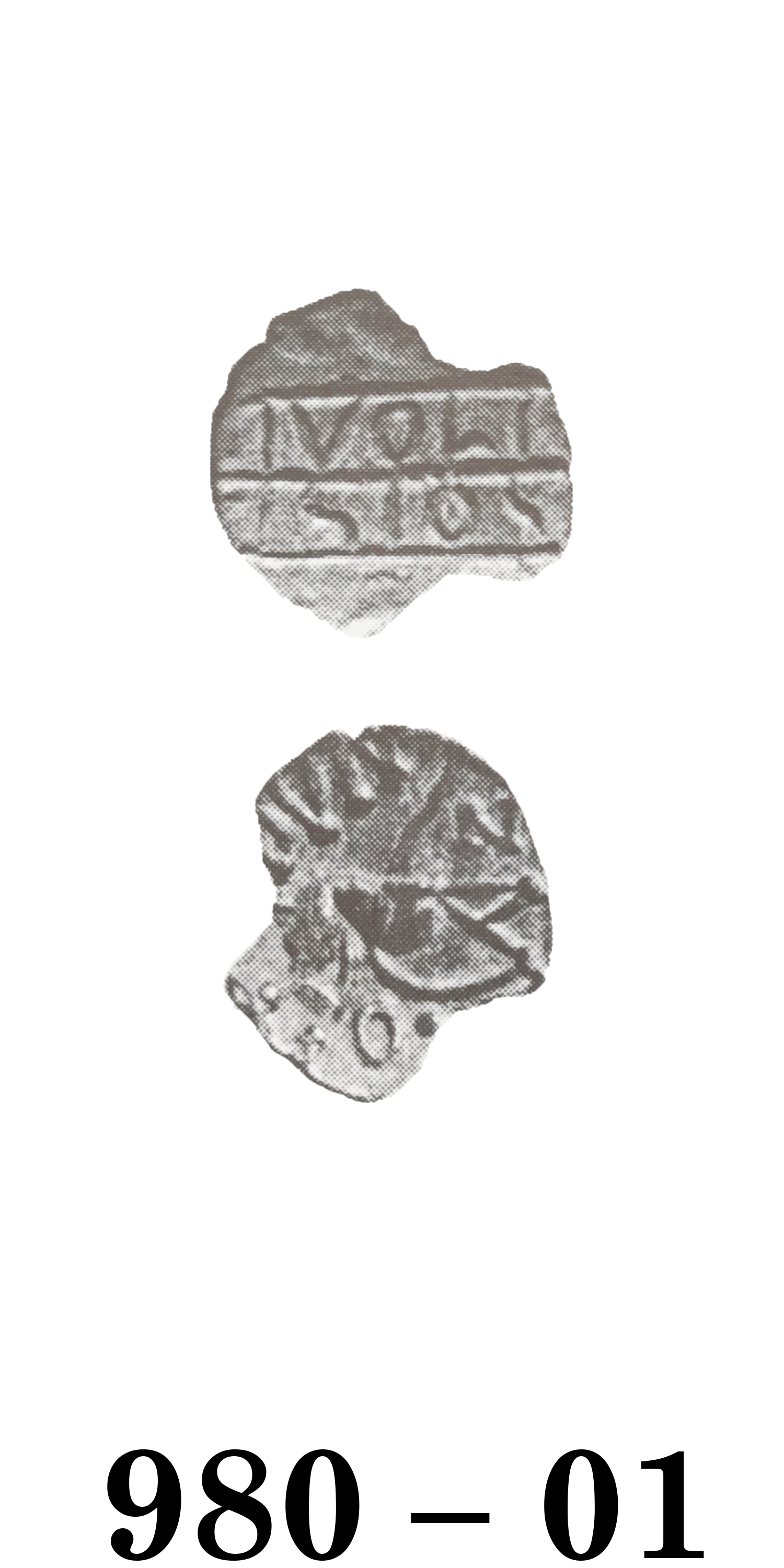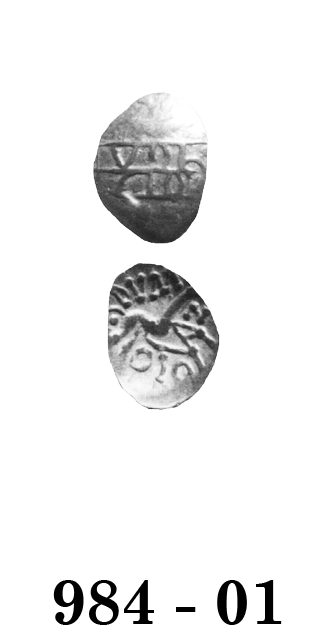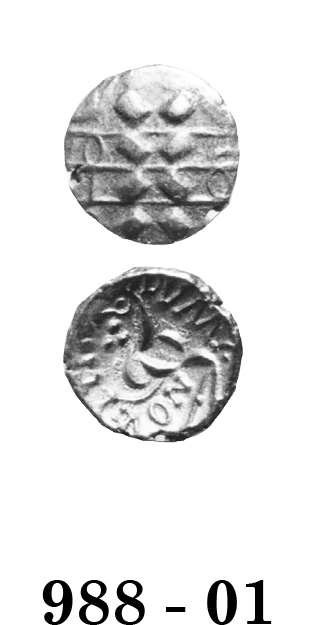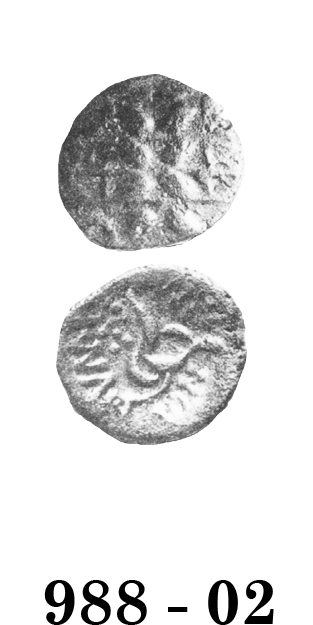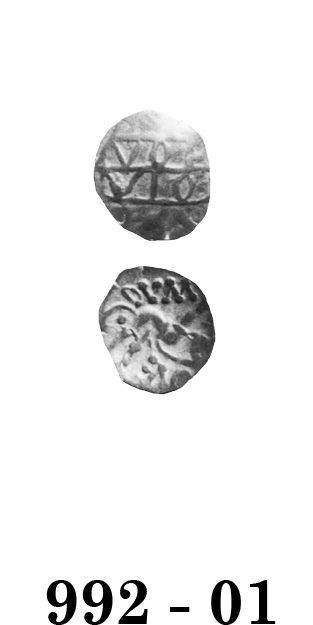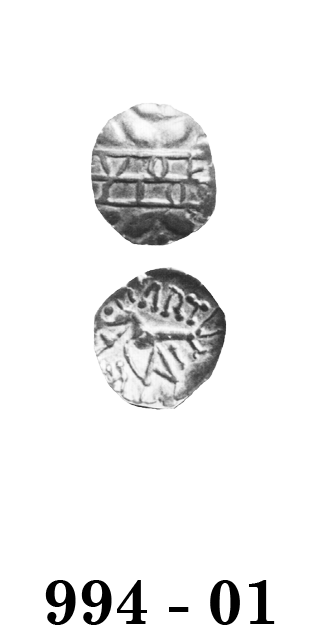
Celtic Coinage of Britain
third edition
Click on coin to see hidden information
Corieltauvian Inscribed Coinage
In the 1980s, when relatively few Corieltauvian inscribed coins were known, it appeared possible to place the various types in a plausible chronological order. The inscriptions were widely believed to be names of rulers, though it was admitted there was little support for the idea.
In the early 2000s, a large number of hoards were found at Hallaton in Leicestershire, adding some 4500 coins to the known total. Many new dies were identified, and it is now certain that the period from 10 to 43 AD has a much more complex story than was imagined.
Four interim reports on the hoards have been published (Cottam 2006, 2007 and Leins 2007, 2011) which have provided much new information about the types and their imagery.
The Coins from 10 to 43 AD
Cottam suggested that the inscriptions had more spelling variations than previously thought. Leins, studying the hoards in detail confirmed that this was true. The spelling variations for types having VEP, AVN and IAT ISO inscriptions at times degenerated into gibberish. Leins suggested that simply placing an inscription on the coins could have been the important point. The inscriptions themselves may not have mattered very much. This brought into question the idea that the inscriptions were really names of rulers – they may have meant nothing at all.
Leins managed to suggest a better reading for the IAT ISO types. He identified TATISOM as the full legend. Unfortunately, the letters on some dies became little more than abstract patterns, virtually unreadable. Thus, TATISOM cannot be taken to mean anything at all. He also suggested a better reading for the ESVP ASV types. The fullest reading is now IISVPRASV. This inscription seems to appear with consistency, and does not degenerate into abstract patterns. Yet, no one can prove it conveys any meaning.
Cottam and Leins have succeeded in providing us with a complete catalog of the inscriptions. They have convincingly constructed “sets” of Silver Units and Half Units. It is unlikely that many more variations will be found. Considerably much more work needs to be done to determine whether the inscriptions say anything plausible
Dating these coins has proven much more difficult. Cottam and Leins, using similar analyses of the hoard contents, attempted to place the various types in chronological order. Though they came up with a vaguely similar order, their results did not completely agree. Both authors pointed out sources of error in their analyses. Cottam noted that some of the hoards could have contained parcels of “heirloom silver” that could throw the results off. Thus, a better understanding of the way the hoards had been assembled is needed. Leins noted that some of the hoards had been plough-damaged, with coins removed and mixed with others in the plough soil. Thus, the accuracy of the hoard content records is not as good as needed. Given the compromised nature of the analysis, the two authors sensibly offered nothing more than general guidelines about the chronology.
Leins suggested that some of the hoards were buried before 43 AD and the rest about 43 AD or a bit later. This meant that VEP, ASV, IISVPRASV and TATISOM types were all in circulation before 43 AD. However the chronological sequences he suggested are speculative at best. In general, it can be said that all four types were probably produced between 10 and 30 AD, or perhaps a bit later. The general consensus is that the VEP and ASV types appear early. But the length of time they were struck is not certain. The chronological relationship of the IISVPRASV and TATISOM types to the VEP and ASV coins is equally uncertain at this point. The general feeling is that they are likely to be later in the sequence.
The Hallaton hoards need much more work, opening up the possibility for new workers to become involved. A comprehensive study of die-links, die wear and coin wear (missing from the four interim reports) might enable the types to be placed in some certain order. Taylor has used this technique to great advantage for the coins of the Iceni.
A rough weight study (Van Arsdell, unpublished) suggests that the silver units were all struck to a standard of 1.30 grammes, with half units at 0.65 grammes. A more detailed study might add additional understanding. The following chart shows the weight distribution of Leins' AVN COST 1 type at Hallaton. A Standard Weight of 1.30 to 1.35 grammes would include about 95% of the coins.
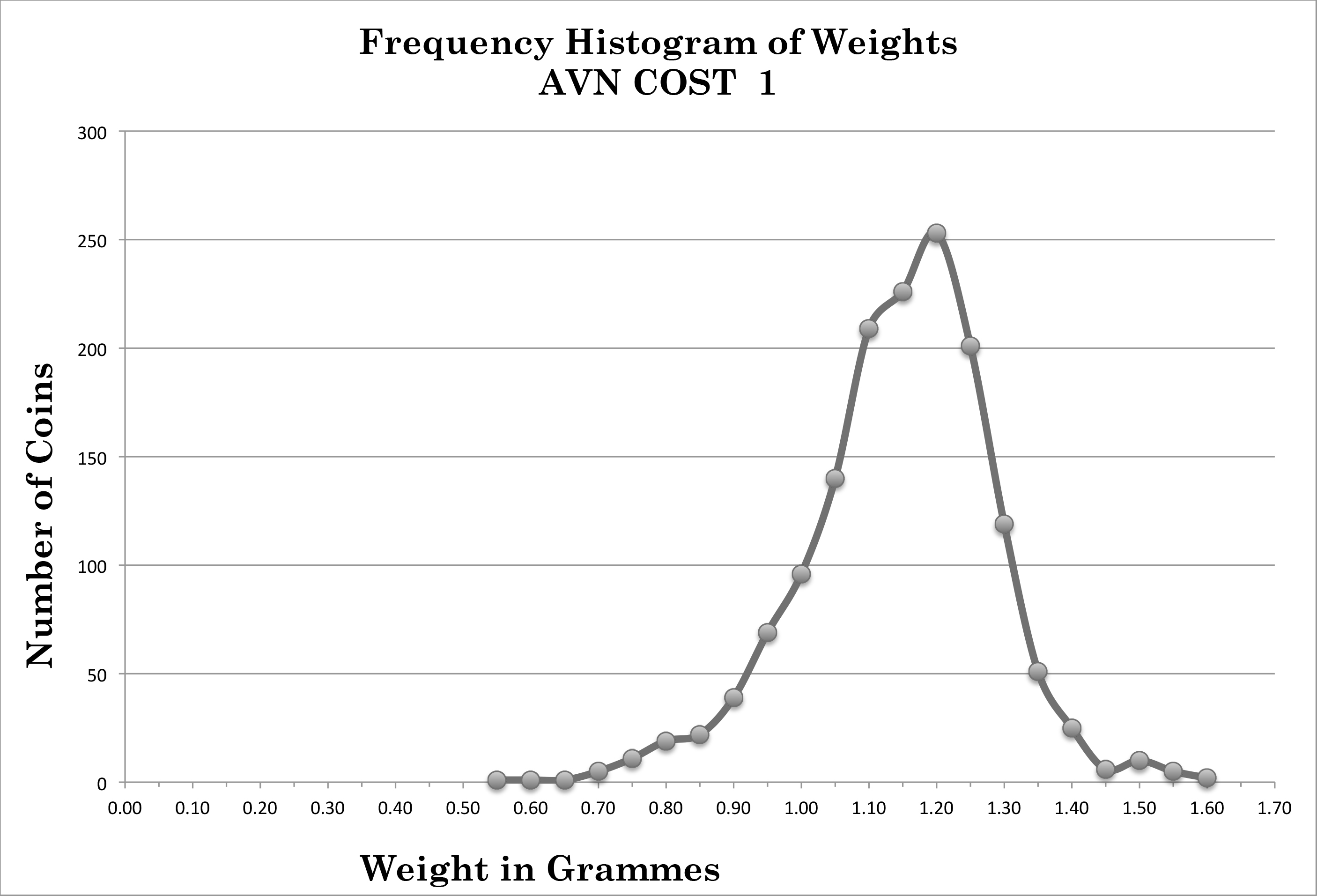
A very small number of coins inscribed DVMNO TIGIR SENO, VOLISIOS DVMNOCOVEROS, VOLISIOS DVMNOVELLAVNVS and VOLISIOS CARTIVEL were found in the Hallaton hoards, showing these types were already in circulation by the time of the Claudian invasion.
The Coins from 43 to 55 AD
The Hallaton Hoards contained too few DVMNO TIGIR SENO and VOLISIOS types to add to our knowledge. They have traditionally been dated later than the VEP, AVN and IISVPRASV types. The DVMNO TIGIR SENO and VOLISIOS legends appear consistently, suggesting they may have conveyed specific meanings.
The Corieltauvian coinage would have come to an end when the Romans suppressed the tribal coinage around 55 – 60 AD. Since the 1990s, Geoff Cottam has conducted a systematic study of Corieltauvian die-links. While some of this information has been published, a full analysis has not appeared. The Hallaton material has added so much new evidence that a die-link study now includes more than 5000 coins – a major undertaking.
In the past, Cottam suggested some of the coins may be local issues and that the dating needed revision. Answering these questions has not been simplified by the finds at Hallaton, because Hallaton has raised more questions than it answers.
The changes in the current catalogue reflects the uncertainty of the Hallaton analyses. The period from 10 to 43 AD is hopelessly confused with four “sets” of inscriptions appearing early: VEP types, AVN types, IISVPRASV types and TATISOM types. The dating of these four is arbitrarily given as 10 to 43 AD, with no attempt at greater precision. The DVMNO TIGIR SENO and VOLISIOS types, probably slightly later, are arbitrarily given 30 – 55 AD dates.
In a break with the past, we can no longer assert that any of these inscriptions are names of rulers.
Much work needs to be done – presenting a unique opportunity for new workers to enter the fray and help find better answers.
Coins Inscribed VOLISIOS DVMNOCOVEROS
Gold staters, plated staters, silver units and half units are known. The three pellets below the horse's neck also appear on the coinage inscribed DVMNOC TIGIR SENO. The VOLISIOS DVMNOVELLAUNUS coinage also has the triple-pellet motif below the neck, but the staters are of greatly reduced weight.
Dating of these coins has become more controversial since the finds at Hallaton. The coins are now arbitrarily dated to 30 - 55 A.D. until better information becomes available
Coins Inscribed VOLISIOS DVMNOVELLAVNOS
Gold staters, plated staters and silver units are all known. The stater has the image style of VOLISIOS DVMNOCOVEROS but weighs less.
Dating of these coins has become more controversial since the finds at Hallaton. The coins are now arbitrarily dated to 30 - 55 A.D. until better information becomes available
Coins Inscribed VOLISIOS CARTIVEL
A core of a plated stater has been reported with the inscription CARTIVEL, and another with a blundered legend DANINLIR (?). Catalogue number 993 - 01 is reserved for a gold stater of CARTIVEL, and 993 -02 for a plated variety.
Attempts have been made in past times to attribute this type to Queen Cartimandua of the Brigantes. Though the idea is tantalizing, there is little evidence to prove the attribution.
Dating of these coins has become more controversial since the finds at Hallaton. The coins are now arbitrarily dated to 30 - 55 A.D. until better information becomes available.
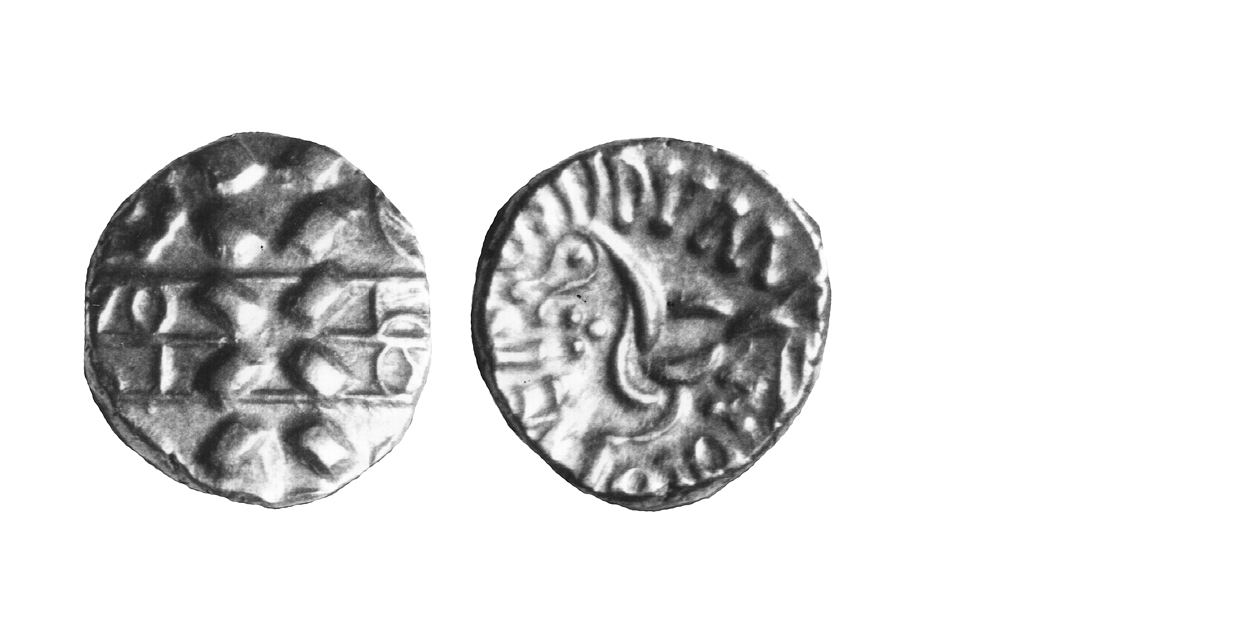
978 - 01 Volisios Dvmnocoveros
30-55 A.D. Scarce
Gold Stater 5.40 gms. 20 mm
Earliest Record: Camden, 1789 (Gough edition)
OBV: Corieltauvian Apollo-Wreath
Identifying points:
1) wreath fills field
2) three horizontal lines run across wreath
3) VO LI between top lines
4) SI OS between bottom lines
REV: Celticized horse left
Identifying points:
1) three pellets below horse's neck
2) DVM NOCO VER OS around horse
CLASSIFICATION: Corieltauvian P
NOTES:
- Some are in museums
- Standard weight given
- Celtic Coin Index now indicates commoner than previously thought
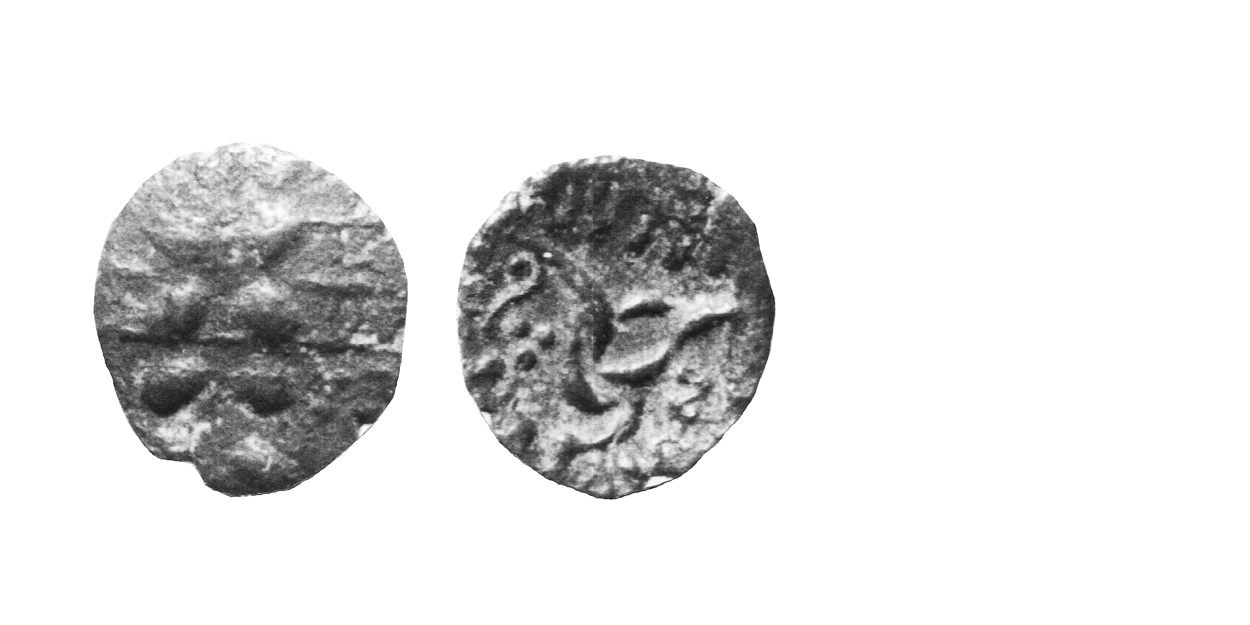
978 - 02 Volisios Dvmnocoveros
30 - 55 A.D. Extremely Rare
Gold/Bronze Plated Stater ca. 3.0 gms. 18 mm
Earliest Record: Allen, 1963
OBV: Corieltauvian Apollo-Wreath
Identifying points:
1) as 978 - 01
REV: Celticized horse left
Identifying points:
1) as 978 - 01
CLASSIFICATION: Corieltauvian P
NOTES:
- Ancient forgery of 978 - 0l
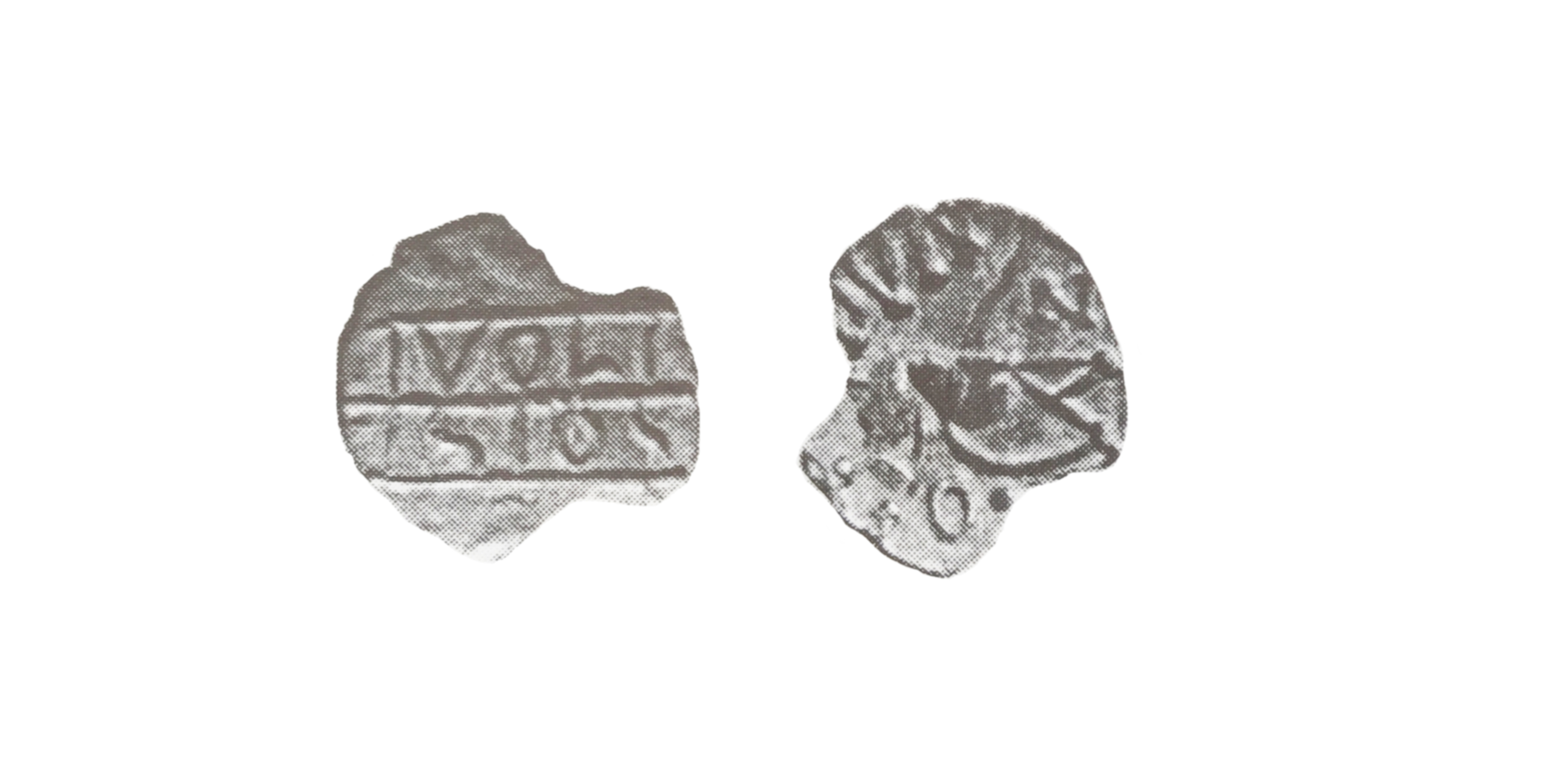
980 - 01 Volsios Dvmnocoveros
30-55 A.D. Extremely Rare
Silver Unit ca. 1.3 gms. 16 mm
Earliest Record: Mack, 1975
OBV: Enlarged Apollo-Wreath
Identifying points:
1) wreath fills field
2) three horizontal lines across wreath
3) VO LI between top lines
4) SI OS between bottom lines
REV: Celticized horse right
Identifying points:
1) three pellets below horse s neck
2) DVMNOCOVEROS around horse
CLASSIFICATION: Corieltauvian P
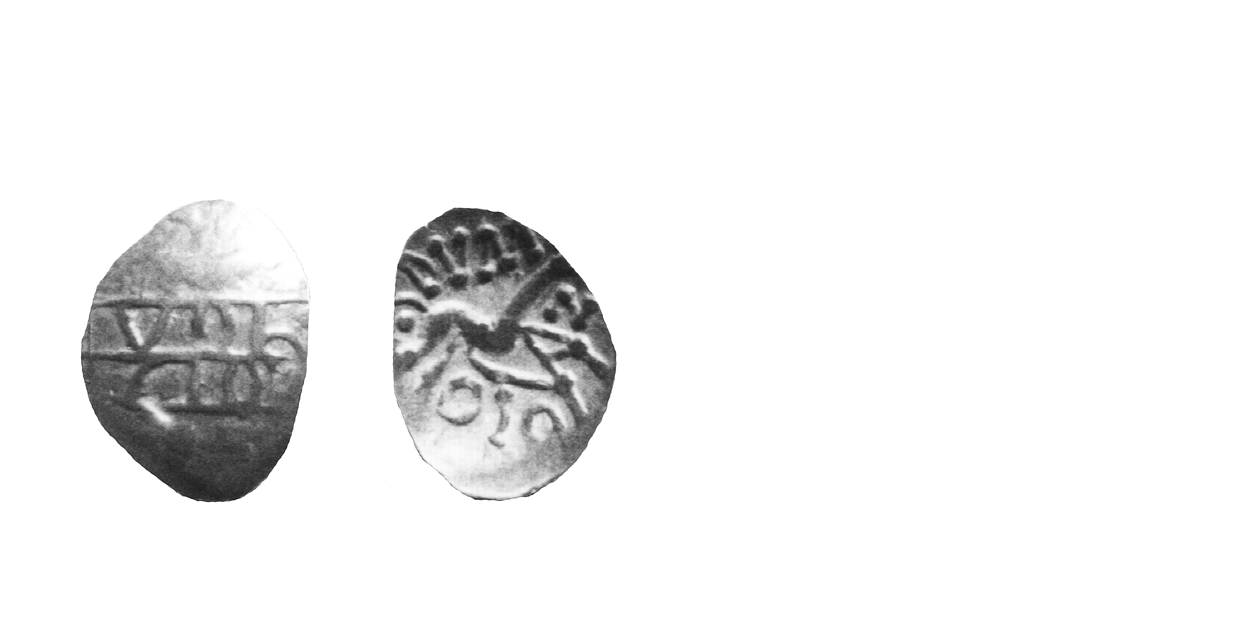
984 - 01 Volisios Dvmnocoveros
30-55 A.D. Extremely Rare
Silver Half Unit ca. 0.8 gms. 15 mm
Earliest Record: Mack, 1953
OBV: Enlarged Apollo-Wreath
Identifying points:
1) wreath fills field
2) three horizontal lines across wreath
3) VO LI between top lines
4) SI OS between bottom lines
REV: Celticized horse right
Identifying points:
1) pellets below horse's neck
2) DVMNOCO around horse
CLASSIFICATION: Corieltauvian P
NOTES:
- Uncertain if the complete "DVMNOCOVEROS" appears around the horse
- Many are in museums
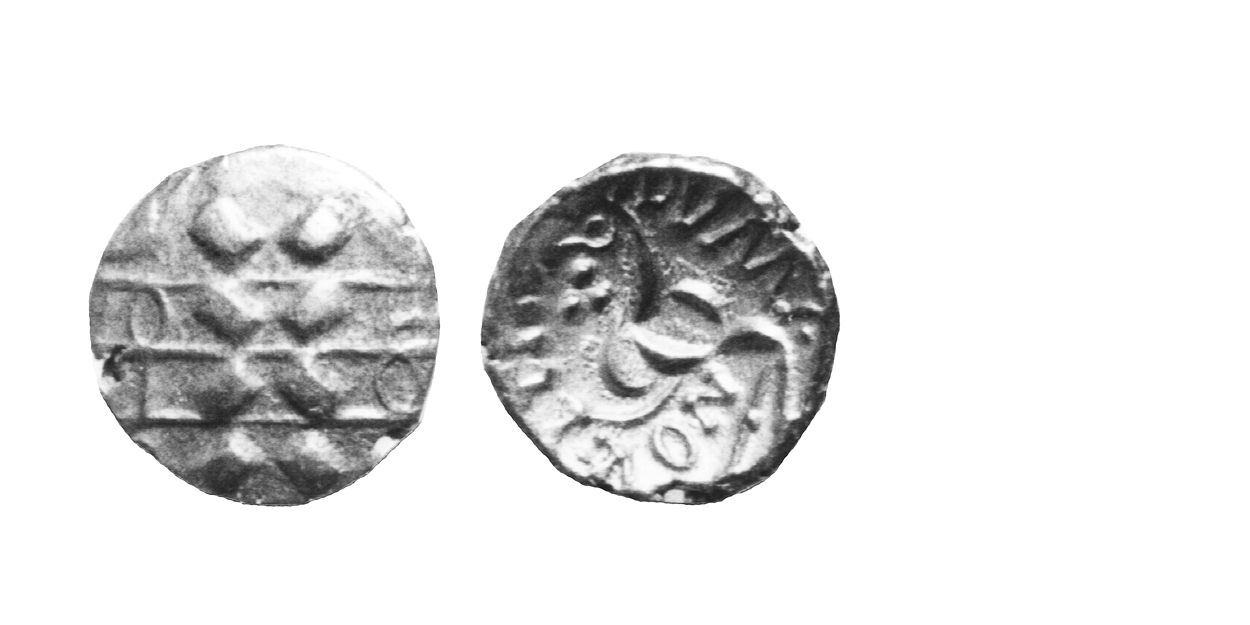
988 - 01 Volisios Dvmnovellavnos
30-55 A.D. Very Rare
Gold Stater 19 mm
Earliest Record: Evans, 1890
OBV: Corieltauvian Apollo-Wreath
Identifying points:
1) wreath fills field
2) three horizontal lines across wreath
3) VO LI between top lines
4) SI OS between bottom lines
REV: Celticized horse left
Identifying points:
1) three pellets below horse's neck
2) DVMNOVELLAVNOS around horse
CLASSIFICATIONATION: Corieltauvian Q
NOTES:
- Typical weight uncertain, thought to be around 5.0 gms
- Some are in museums
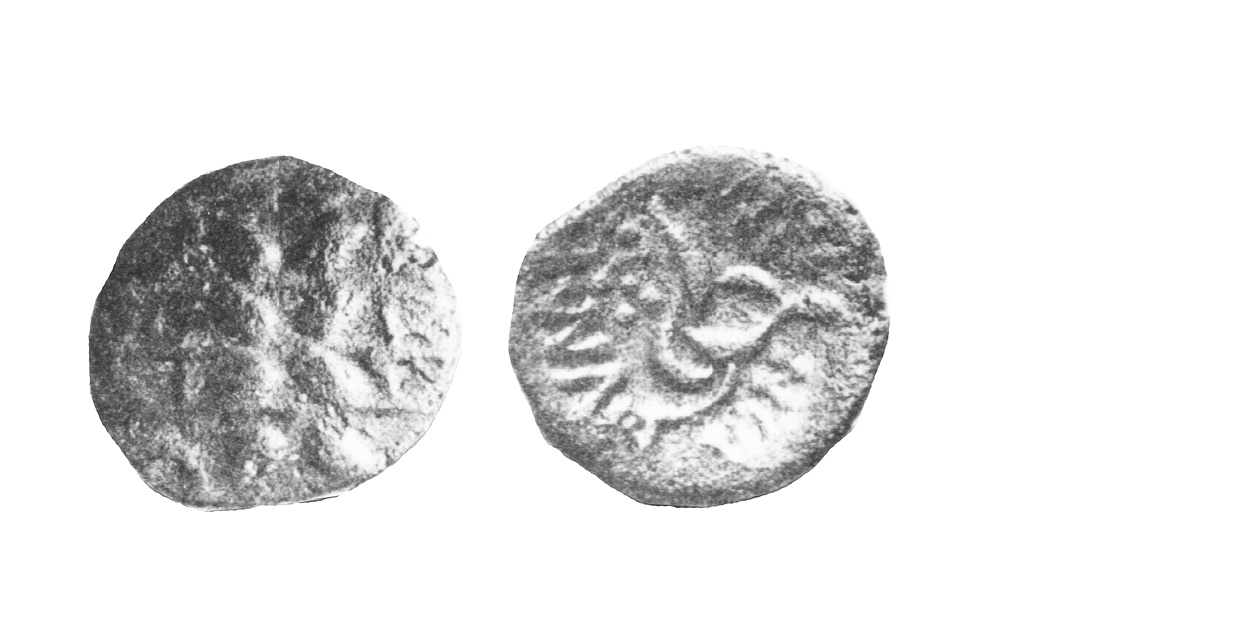
988 - 02 Volisios Dvmnovellavnos
30-55 A.D. Extremely Rare
Gold/BronzePlated Stater 3.9-4.8 gms. 20 mm
Earliest Record: Allen, 1963
OBV: Corieltauvian Apollo-Wreath
Identifying points:
1) as 988 - 01
REV: Celticized horse left
Identifying points:
1) as 988 - 01
CLASSIFICATION: Corieltauvian Q
NOTES:
- Ancient forgery of 988 - 01
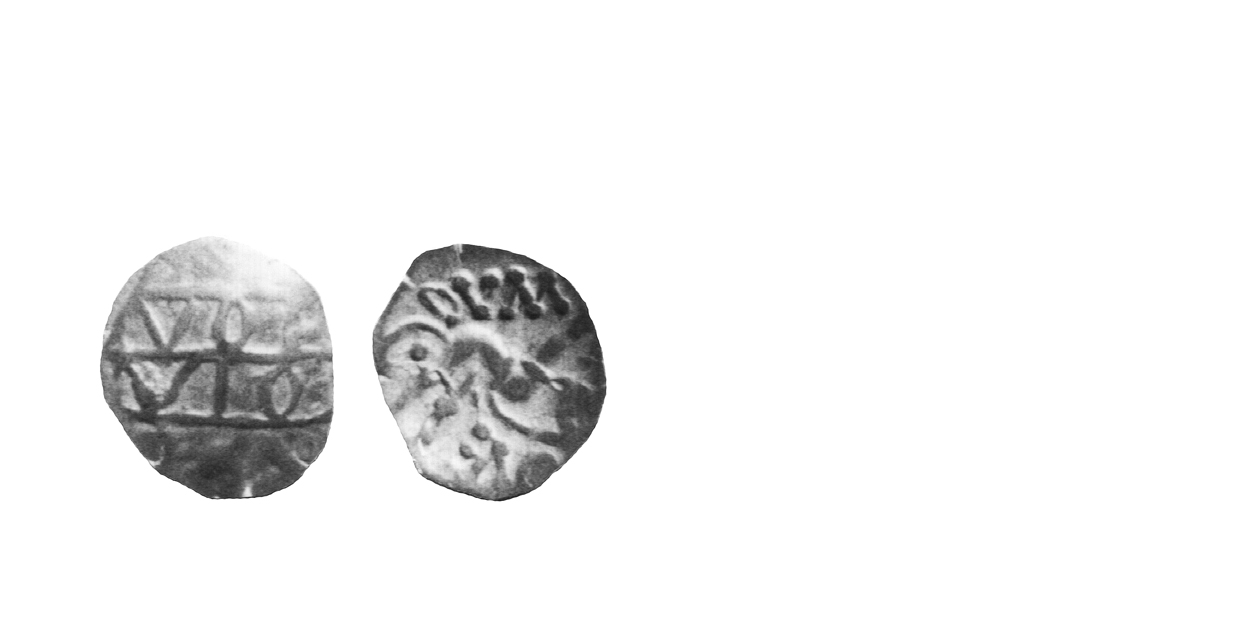
992 - 01 Volisios Dvmnovellavnos
30-55 A.D. Extremely Rare
Silver Unit ca. 0.5 gms. 13 mm
Earliest Record: Mack, 1953
OBV: Enlarged Apollo-Wreath
Identifying points:
1) wreath fills field
2) three lines across wreath
3) VO LI between top lines
4) SI OS between bottom lines
REV: Celticized horse right
Identifying points:
1) pellets below horse's neck
2) DVMNOVE around horse
CLASSIFICATION: Corieltauvian Q
NOTES:
- Uncertain if the complete "DVNMOVELLAVNOS" appears around the horse
- Most are in museums
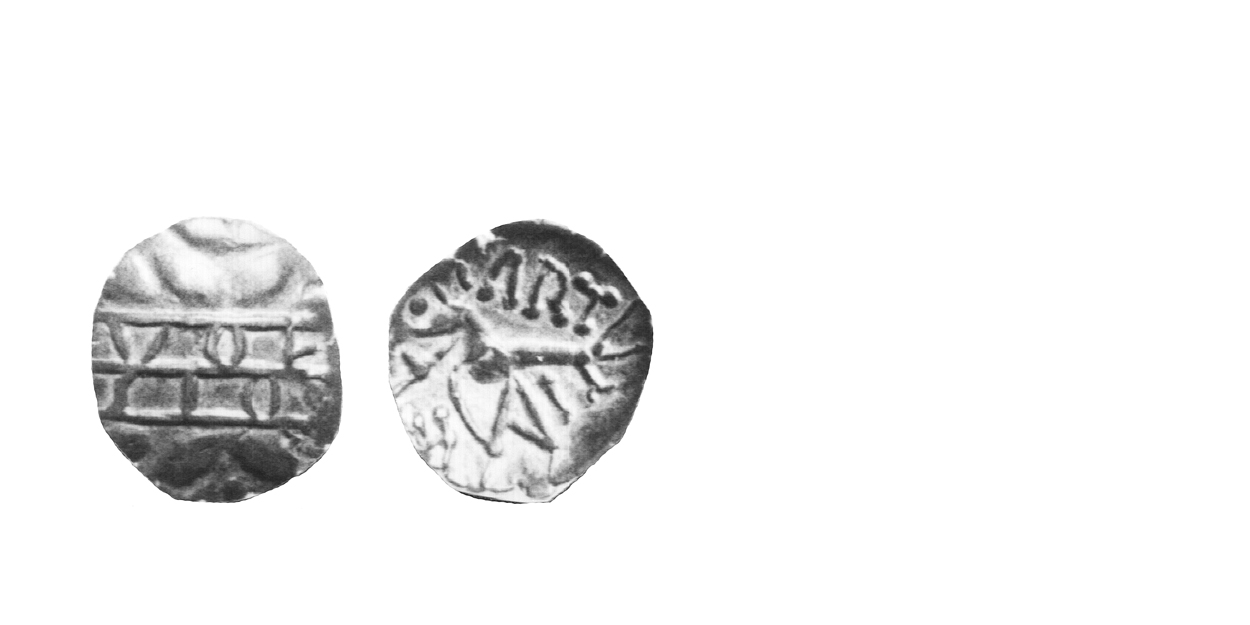
994 - 01 Volisios Cartivel
30-55 A.D. Extreemly Rare
Silver Unit ca. 0.5 gms. 15 mm
Earliest Record: Allen, 1944 (Honley Hoard, 1897)
OBV: Enlarged Apollo-Wreath
Identifying points:
1) wreath fill the field
2) three horizontal lines across wreath
3) VO LI between top lines
4) SI OS between bottom lines
REV: Celticized horse right
Identifying points:
1) pellets below horse's neck
2) CARTIVEL around horse
CLASSIFICATION: Corieltauvian R
NOTES:
- The type was once believed to be the coinage of Queen Cartimandua, but this is now thought unlikely
- Some are in museums
The Coinage of the Corieltauvi
The Corieltauvi occupied Lincolnshire, Leicestershire, Nottinghamshire, parts of Humberside and perhaps parts of Derbyshire and South Yorkshire. The correct name of the tribe, obtained from a tile-grafitto found in 1965, is CORIELTAUVI. In the past, the tribe had been known as the "Coritani", but the new spelling has been widely accepted. The Corieltauvi, for many years, were thought to be a largely peripheral tribe, untouched by the changes transforming southern Britain. This view has been questioned by archaeological studies made after 1960. They are now considered to have been an advanced group – early to adopt the potter's wheel, for example.
Recent studies indicate the coinage was one of the earliest struck in Britain, appearing shortly after the Atrebatic/Regnan/Belgic Westerham stater. The Corieltauvi struck coins continuously until the Claudian invasion or later. The coinage has a complex system of privy marks that may have been used for die control, weight specification or perhaps identification of metallurgical content.
The coinage was at one time thought to have a Brigantian origin because several large hoards were found in the territory of that tribe. However, more comprehensive analyses of findspots identify a primarily Corieltauvian source. Recently, assertions have been made that northerly finds of late types are Brigantian, but this is a case of over-interpretation of insufficient information. Given the fluid conditions after the Claudian Invasion, the location of the Corieltauvian mint may have shifted north. Similarly, the final resting places of the latest coins would naturally tend to be in the north. The possibility that the Brigantes struck some of the later types remains. But too little information exists at this time to prove a separate Brigantian coinage.
The coinage begins around 55 B.C. with the NORTH EAST COAST TYPE, derived stylistically from the Abstract Design Type staters of the Ambiani. These coins, struck to a standard weight of 6.25 grammes, appeared in two versions. The horse on the reverse faces either right or left, and previously it was felt the change signaled a difference in the weight of the two types. However, more recent weight studies show the difference is smaller than thought. In the current catalogue, the two are listed as a single issue. The NORTH EAST COAST TYPE was replaced about 45 B.C. by the SOUTH FERRIBY TYPE, signaling a significant weight reduction to 5.7 grammes.
The South Ferriby Type and its variations display the most complex series of privy marks found on any Ancient British coinage. Cleverly-made plated forgeries are known for most types. The forgeries were produced by hammering gold foil around a bronze core prior to striking, and some of the forgeries appear to be struck from official dies. The similarity between genuine and false coins, however, may only indicate the extent of technological knowledge amongst the tribal population – the forgers may have been as expert as the mint-workers in die-cutting. The proficiency of the forgers may help explain the need for complex privy marks on the genuine coins. Alternatively, future metallurgical studies may prove the marks signal changes in the gold/silver/copper relationship instead and thus serve as assay marks.
A long series of inscribed coins followed the uninscribed, and the coinage ended with the Roman suppression of tribal coinage during the fifties A.D.
Evidence of a Celtic mint has been discovered at Old Sleaford. However it is not known if it was the only Corieltauvian mint, nor if it was the mint producing all the coins listed in this catalogue.
Since the 1990's, a systematic study of Corieltauvian die-links has been performed by Geoffrey Cottam, who has published some of his findings. He has suggested that some of the coins may be local issues, and others may need later dating. It is possible that the chronology given here may need revision when Cottam's full analysis is published.
